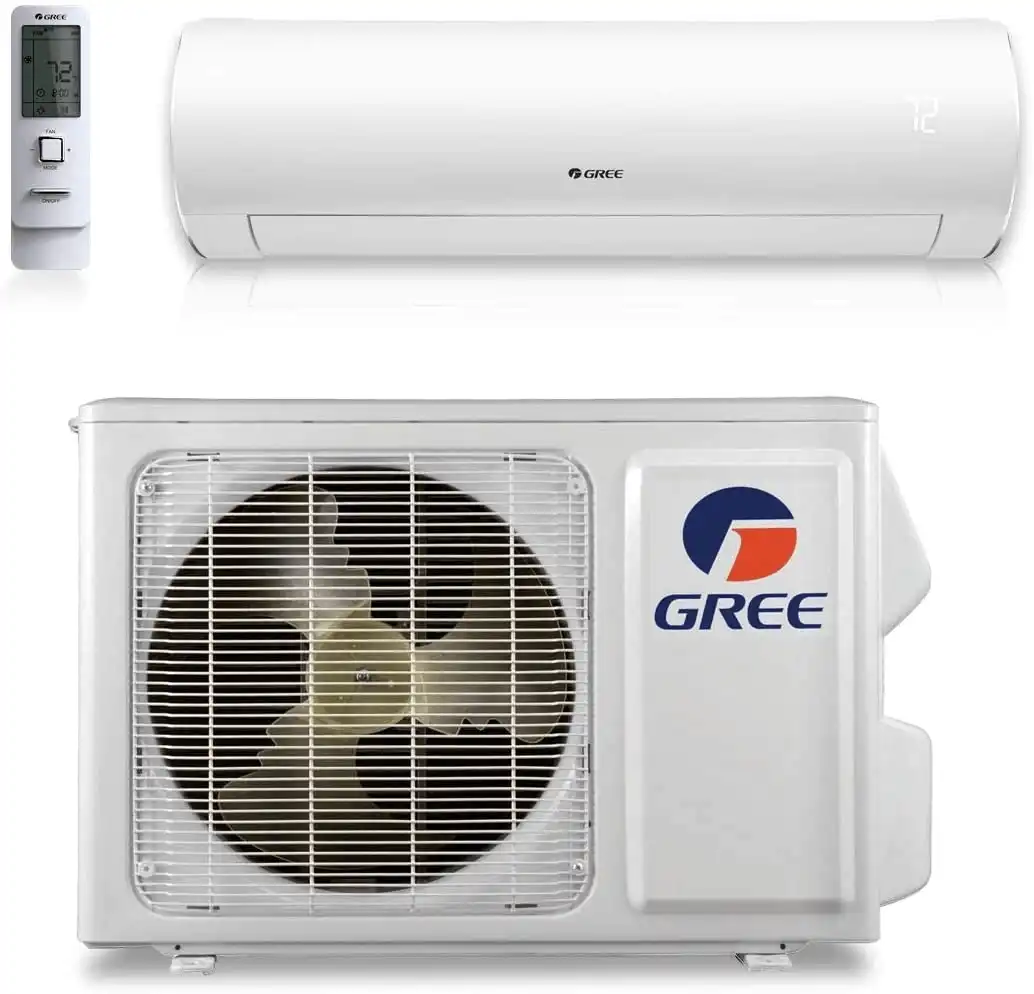
How to Quiet Noisy Mini-Split Heat Pumps
Is Your Client's Heat Pump Making Noise? Learn to Quiet Noisy Mini-Split Heat Pumps with GREE's Expert Tips for HVAC Contractors
If you're an HVAC contractor working with GREE mini-split heat pumps, you know these systems are designed for quiet operation. However, issues such as loose parts, airflow restrictions, or worn-out components can still cause unwanted sounds. Below we've provided a guide with targeted steps you can take to help you address noise problems and maintain optimal performance on the job.
While noises such as rattling, whistling, grinding, or buzzing can indicate issues, note that minor vibrations or a soft buzzing—particularly from components like the 4‑way valve or during compressor startup—are normal for inverter-driven systems, per GREE's system documentation.
Finding the Noise Source
Finding the Noise Source: From Heat Pump Humming Noise Inside to Mini-Split Fan Noise
Tracking down the source of noise, whether it's a heat pump humming noise inside or a mini-split condensate pump noise, requires a step-by-step approach. Both the indoor and outdoor units should be carefully inspected to locate the issue.
Inspect Both Mini-Split Heat Pump Units
Check the indoor and outdoor units for loose hardware, dirty filters, or debris build-up. This step can be done by homeowners, but if abnormal noise persists after routine cleaning and inspection, use GREE's Contractor Locator tool or consult a GREE-certified HVAC technician for diagnostics and repair, they can (and should) do the steps outlined below for you.
Noise Testing Steps
If a simple inspection of the system, doesn't reveal the culprit responsible for the mini-split noise, you can go through the noise-testing steps below to help narrow it down.
Initial Assessment
Run the heat pump through its heating, cooling, and fan-only modes. Pay close attention to when noises occur, especially during start-up or shutdown. When testing in heating or cooling mode, give the unit a high temperature demand and leave fan on auto, make sure you're running the unit in Turbo mode.
Indoor Unit Inspection
Check the blower wheel alignment, motor mounts, and filter condition. Adjust the fan speed to see if the noise changes. Afterward, apply the same careful inspection to the outdoor unit. Be sure to use a flashlight and check the blower wheel for dirt buildup.
Outdoor Unit Evaluation
Look at the compressor, fan blades, and the stability of the mounting pad. Test the system under different outdoor conditions to see if the noise varies. Looking at the compressor is like popping the hood on a car – Yep, the engine is there! Be sure to inspect the condenser coil for dirt or damage.
Clean and Tighten the Components of Each Mini-Split Unit
Testing the system. Dirty and loose mini-split components may or may not be causing the noises, however it is a good practice to clean and tighten them up while you're working on the system, and depending on the cause of the heat pump noise, this could resolve the issue. Clean condenser coils, fan blades, and air filters to ensure built-up grime isn't contributing to the noise. Tighten any loose panels or mounting brackets. This is a critical next step for reducing mini-split heat pump noise and preventing future issues.
Replace Damaged Mini-Split Parts and Components
If the noise persists after cleaning and tightening the mini-split heat pump components, grinding or scraping sounds may require replacing fan motors, bearings, or other components. If these parts are damaged, they can cause noise as they interact with other components in the system. The system may still work, but these damaged parts could be contributing to the noise. You can refer to the table below to help identify which part may need to be tightened, cleaned, or replaced, depending on where the heat pump noise is coming from.
Types of Heat Pump Noises
Certain mini-split noises can point to specific mechanical problems. As you're inspecting the units, you can refer to the table below for a simplified guide to noise types and probable causes; however, for definitive troubleshooting and error code diagnosis, please consult the detailed procedures in GREE's official system documentation:
| Noise Type | Location | Probable Cause | Urgency Level | Source Documentation |
|---|---|---|---|---|
| Water flowing/gurgling | Indoor/Outdoor | Refrigerant pressures equalizing during compressor start/stop cycles (normal operation) | Low | Installation Manual1 |
| Thin fog/vapor emission | Indoor unit | Rapid cooling of humid air causing temporary condensation (normal dehumidification process) | Low | Installation Manual1 |
| Slight cracking | Indoor unit | Thermal expansion/contraction of components during system starts/stops | Low | Installation Manual1 |
| Vibrational noise | Outdoor unit | Missing or inadequate riser legs for vibration absorption | Medium | Installation Manual1 |
| High-pitched fan whine | Indoor unit | Airflow restriction from dirty filters or blocked coils | Medium | Owner's Manual3 |
| Loud compressor hum | Outdoor unit | Normal inverter-driven compressor operation during capacity adjustments | Low | Service Manual4 |
| Intermittent buzzing | Wired controller | Low battery warning in remote control devices | Low | XE70 Controller2 |
| Defrost cycle noises | Outdoor unit | Ice melting during automatic defrost operation in heating mode | Low | Vireo Gen3 Manual3 |
| Irregular knocking | Both units | Loose refrigerant lines or unsecured drainage pipes | High | Installation Manual1 |
| High-speed airflow noise | Indoor unit | Normal operation at maximum fan settings (can be reduced using Quiet Mode) | Low | XK79 Controller |
Common Heat Pump Noise Complaints and Simple Fixes
Below are a few frequent heat pumps noise complaints and straightforward remedies:
- Heat pump making grinding noise when shutting down? Check bearings and fan motor alignment.
- Heat pump outdoor unit making screeching noise: Inspect fan blades.
- Mini-split fan noise: Ensure no debris is obstructing fan blades and that they're balanced.
Addressing these common complaints quickly can often resolve or prevent more significant problems down the line.
In addition to completing the steps above, any contractor working on a GREE system should review the installation to ensure the unit is installed strictly according to GREE's installation specifications and in compliance with all local building and noise ordinances. Proper mounting, clearance, and refrigerant line routing help minimize vibration and noise from mini-splits and maintain a comfortable mini-split noise level.
Mini-Split Outdoor Unit Relocation
Occasionally, the reason behind a noisy heat pump is due to a poor installation or placement of the outdoor unit. Relocating the outdoor unit can help reduce noise levels. Place it on a flat surface and use vibration-dampening pads. In cold climates, heat pumps need to be mounted on stands above the snow line, which also allows for proper drainage during and after defrost. Keep the unit away from walls, windows, and outdoor areas where noise might be disruptive. Make sure to maintain proper airflow clearance and follow local building codes and manufacturer guidelines. This option should really only be considered when the placement of the unit is clearly the issue causing the noise.
Mini-Split Outdoor Unit Installation Best Practices
If you do need to relocate your client's outdoor unit, proper installation is key to avoiding unnecessary noise going forward. Stick to the manufacturer's instructions to reduce vibration and misalignment. Here are some must-dos for installing outdoor units to minimize noise:
- Use mounting brackets that can handle the unit's weight
- Leave enough clearance around the outdoor unit
- Secure and insulate refrigerant lines
- Ensure both indoor and outdoor units are perfectly level
- Place the indoor unit where the manufacturer recommends
- Mount the outdoor unit on a solid, level base
- Avoid installing the outdoor unit near a window or near a bedroom
- In cold climates heat pumps need to be mounted on stands above the snow line this also allows for proper drainage during and after defrost
These steps help prevent noise-related problems from the start.
Mini-Split Heat Pump System Replacement Options
If repairs are too expensive or the system is outdated, it could be work speaking with your client about replacing the mini-split heat pump. Newer models often come with inverter-based compressors, better fan designs, and built-in dampening features. And if the existing system is of a lesser quality, installing a GREE mini-split system will help ensure your clients live with quiet comfort all year long. When choosing a replacement, consider factors like noise sensitivity, available space, energy efficiency priorities, and budget. GREE Comfort offers quiet mini-split systems designed with noise reduction and energy efficiency in mind.
Choosing Mini-Split Heat Pump Systems Quiet Systems
Even with great maintenance and installation, picking a system built for quiet operation makes a big difference. Many modern systems feature technologies that keep noise to a minimum.
| Feature | How It Helps Reduce Noise |
|---|---|
| Inverter Technology | Smooth operation without loud startups |
| Multi-Speed Fans | Quieter performance at lower speeds |
| Sound-Dampening Materials | Limits vibration transfer |
| Advanced Compressor Design | Cuts down on operational noise |
For noise-sensitive applications, consider systems like GREE's single-zone, multi-zone, or MultiPRO models. They combine quiet operation with energy efficiency, making them a practical choice for long-term performance.
Maintain Mini-Split Systems to Reduce Heat Pump Noise
For long-term quiet performance, strictly follow GREE's recommended maintenance intervals, which include checking the indoor unit's air filter monthly. Permanent filters do not need to be replaced unless damaged, while disposable filters should be replaced every 3–6 months, depending on usage and model. Clean the indoor coils every 6 months, with occasional deep cleaning depending on the environment. The outdoor coil should be cleaned at least once a year. If you're installing a new system for your client, ensure proper installation to prevent many noise-related issues from arising in the first place.
Properly diagnosing and resolving mini‑split heat pump noise issues is essential for delivering quiet, efficient performance and ensuring your clients' comfort. By following the targeted steps in this guide—inspecting both indoor and outdoor units, running noise‑testing procedures, cleaning and tightening components, and replacing worn or damaged parts—you'll achieve professional, long‑lasting results every time. HVAC contractors can dive deeper with our instructional videos, browse the FAQ page for quick answers, consult the full system documentation for detailed procedures, or use the System Builder tools to design and size the ideal quiet‑operation system. If you're a homeowner who needs help with a noisy mini-split heat pump, connect with a certified GREE Comfort specialist in your area through our Contractor Locator tool for installation, troubleshooting, and ongoing maintenance.




